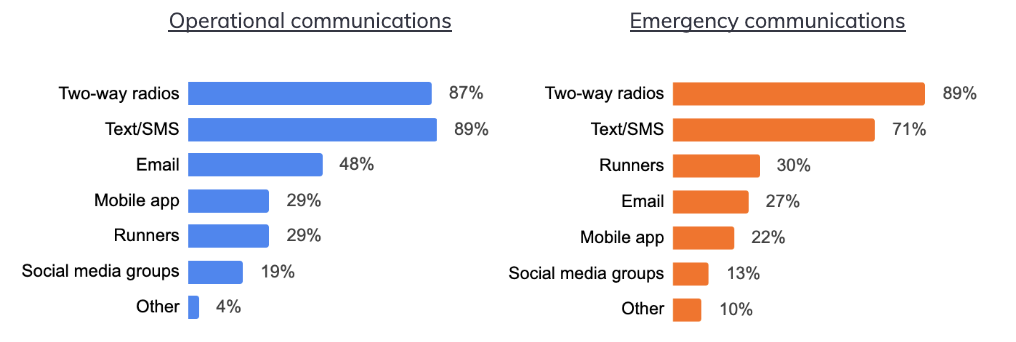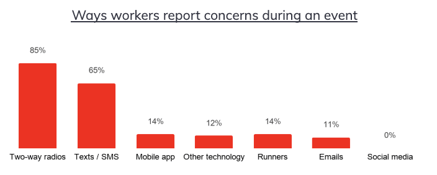Blerter recently carried out a survey with Event Risk Management Services (ERMS). Over 160 event directors and owners responded from 11 countries.
Communication channels and their effectiveness was one of the central topics in the survey. One of the key takeouts was that the more things change, the more they stay the same - radios are the most common method for both operational (87%) and emergency (89%) communications.
The use of text messaging (89% and 71% respectively) shows that event organizers are well on their way to capitalizing on the near-univesal penetration of mobile phones and smart devices. The use of mobile apps and social media to disseminate important information is growing, but the use of email by 27% of respondents for emergency communications must be a concern.

When it comes to managing risk, and responding effectively to incidents, information is really the key. The right people, with access to the right information, without delay or confusion. Most event control centers undoubtedly have protocols for reporting incidents to medical responders, security and police officers at an event.
However, there does appear to be room for improvement on the receiving--information side, with only 65% having their workers use text messages and 14% a secure mobile app to report concerns. 85% say that their workers use radios, but the delay in finding someone trusted with a radio could make a significant difference in the timeliness and effectiveness of the response

With these survey statistics in mind, we have six questions to start a journey of self-analysis on the topic of events' internal communications strategy, and because we all like simple, easy-to-remember frameworks, we're going with that staple of high school English teachers the world over : the 5 Ws plus H.
1. WHO do you need to get information to, and WHO do you need to get information from?
With a workforce that expands exponentially in a short space of time, you may not be able to look each volunteer, contractor, vendor or seasonal worker in the eye and check that they're on board with your vision for the event and the way you want tasks carried out. You probably can't sit each person down and explain how important it is to you that they let you know of anything at all that they see, hear or sense that concerns them.
You do need to make sure that every person has the information you want them to have, that it is easy to find and quick to access - and you also want to know that they have sighted it and when. Ditto on information coming back in to you, you need it quickly and you need the context. Using people's own devices and a simple event app makes this easy.
2. WHAT information do you want everyone to have, and WHAT information do you want different teams or groups of people to have?
Handing out 130-page event manuals is not only contrary to your 2020 theme of sustainability, it also means people have point-in-time information, not the latest updates. Emailing them as PDFs is ineffective too, as we know a most people don't read past the first paragraph in an email, let alone a long attachment. Emailing or distributing each relevant section individually? Who has the time?!
A secure software platform with mobile accessibility means that people can see the most up-to-date version of each piece of information that you want them to have, and save your active sending for updates or urgent information. It also means your teams can communicate without creating background noise or clogging up your inbox.
3. WHEN do your people need to receive or access information? WHEN it matters...
A safety briefing is essential to your on-boarding, as is some sort of check-in process with an opportunity for your wider team to be brought up to date with important information. However, changes occur at the last minute and on the day - evacuation maps and schedules are only useful in the moment if your team members can access them in real-time and get the 'right-now' details, not the 'last-month-in-planning' information.
4. WHERE do individual members of your team find the information that you need them to have? WHERE should they send that incident report form or status update?
Sending out emails and text messages, having updated maps and processes at physical check-in points, putting together binders full of safety processes and incident report forms at your control center, sending runners out with updates, or notifying team leaders of schedule changes over radio channels - all of these create the illusion of communication. The information is there, if only your wider team could remember where to find it.
The moment when a volunteer or ticketing employee or facilities contractor needs a piece of information is likely to be a moment under stress. Whether it is to report a burst water pipe or answer an athlete's rushed query, your team need to be able to go straight to the truth rather than cast around for someone with a radio or scroll through their inbox looking for a week-old email. Having a single source of truth lets you control the information, make sure it's up to date, and also means that you are less likely to miss information coming back in.
5. WHY does communication matter so much? WHY can't you just go on as you always have, with runners, radios and required reading?
This one is obvious, easy to answer but the opposite of simple.
Events are like a very complicated acrobatic routine, far too many moving parts to seem achievable : bodies soaring through the air at impossible heights, lights and music needing to be perfectly timed, sweat and greasepaint turning hands slippery, impossible temporary structures needing to be withstand all sorts of pressure - and all under the expectant eye of hundreds or thousands of paying customers. Plus unpredictable weather and people.
As an organizer, you need to have the right information being communicated to you without delay and without going through too many pairs of hands. And you need to be sure that the right information is going to the right people, accessible from a single (accurate) source and in a way that is manageable and personal to them. So that you can make the right decisions, and so that your team can do the right thing - every time.
6. HOW can you possible achieve all of these things, without blowing apart your budget or creating so much complexity that your event becomes impossible?
There are two survey statistics to help answer you start to answer this question.
51% of people say that they change the way in which they communicate with their team and wider workforce in an emergency. Which is fine for you and your close team, you're in close contact and know where to go - but for your volunteers and temporary workers? Not so much.
92% say that all, most or some of their wider event team use their own smartphones when working at their event. You don't want your people glued to their screens, but why not make the most of the technology - you have the power.
SUMMARY
An event delivery software platform is not the answer to all of your communication questions, but it does let you do a few crucial things :
A. Reach all, or almost all of the people working and volunteering at your event in a moment
B. Control the information - share just the information people need, and be able to verify that they have seen it
C. Control access to sensitive information - not put your team members at risk by having photos of lost children or injured athletes in their personal photo albums
D. Do your bit for the planet. Paper and printing don't cost a lot in monetary terms, but while you're getting the green tick for recycling and sustainable waste management at your event, why not start with your own processes and say goodbye to those long, outdated and (you know it) mostly unread event manuals?
"The single biggest problem in communication is the illusion that it has taken place."
George Bernard Shaw
For some advice on streamlining and improving your communication strategy, and the right tools to do it, talk to us here at Blerter.
For more information and some advice on crisis communication planning, download the guide below.
Streamline your delivery, be prepared for things that can go wrong and increase crew engagement at your next event.